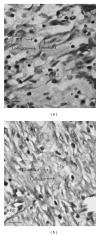Mechanism of Wound-Healing Activity of Hippophae rhamnoides L. Leaf Extract in Experimental Burns
- PMID: 19946025
- PMCID: PMC3152935
- DOI: 10.1093/ecam/nep189
Mechanism of Wound-Healing Activity of Hippophae rhamnoides L. Leaf Extract in Experimental Burns
Abstract
The present investigation was undertaken to evaluate the healing efficacy of lyophilized aqueous leaf extract of Sea buckthorn (Hippophae rhamnoides L., family Elaeagnaceae) (SBT) and to explore its possible mechanism of action on experimental burn wounds in rats. The SBT extract, at various concentrations, was applied topically, twice daily for 7 days. Treatment with silver sulfadiazine (SSD) ointment was used as reference control. The most effective concentration of the extract was found to be 5.0% (w/w) for burn wound healing and this was further used for detailed study. The SBT-treated group showed faster reduction in wound area in comparison with control and SSD-treated groups. The topical application of SBT increased collagen synthesis and stabilization at the wound site, as evidenced by increase in hydroxyproline, hexosamine levels and up-regulated expression of collagen type-III. The histological examinations and matrix metalloproteinases (MMP-2 and -9) expression also confirmed the healing efficacy of SBT leaf extract. Furthermore, there was significant increase in levels of endogenous enzymatic and non-enzymatic antioxidants and decrease in lipid peroxide levels in SBT-treated burn wound granulation tissue. The SBT also promoted angiogenesis as evidenced by an in vitro chick chorioallantoic membrane model and in vivo up-regulated vascular endothelial growth factor (VEGF) expression. The SBT leaf extract had no cytotoxic effect on BHK-21 cell line. In conclusion, SBT aqueous leaf extract possesses significant healing potential in burn wounds and has a positive influence on the different phases of wound repair.
Figures





References
-
- Singer AJ, Clark RAF. Cutaneous wound healing. The New England Journal of Medicine. 1999;341(10):738–746. - PubMed
-
- Gupta A, Upadhyay NK, Sawhney RC, Kumar R. A poly-herbal formulation accelerates normal and impaired diabetic wound healing. Wound Repair and Regeneration. 2008;16(6):784–790. - PubMed
-
- Arturson G. Pathophysiology of the burn wound and pharmacological treatment. The Rudi Hermans Lecture, 1995. Burns. 1996;22(4):255–274. - PubMed
-
- Thomas GW, Rael LT, Bar-Or R, et al. Mechanisms of delayed wound healing by commonly used antiseptics. Journal of Trauma. 2009;66(1):82–90. - PubMed
-
- Lee A-RC, Leem H, Lee J, Park KC. Reversal of silver sulfadiazine-impaired wound healing by epidermal growth factor. Biomaterials. 2005;26(22):4670–4676. - PubMed
LinkOut - more resources
Full Text Sources
Miscellaneous

